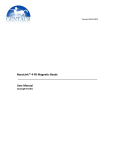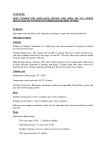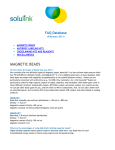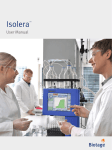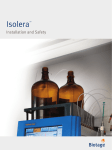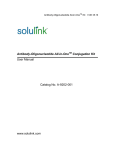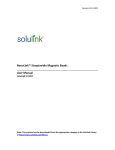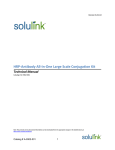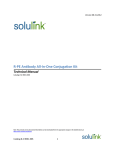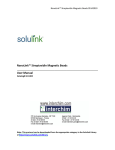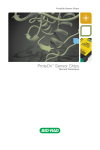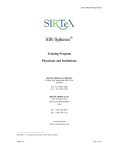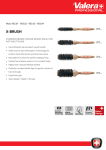Download NanoLink Amino Magnetic Beads
Transcript
Version 08.30.2012 NanoLink Amino Magnetic Beads _______________________________________________ User Manual Catalog# M-1000 Note: This protocol can be downloaded from the appropriate category in the Solulink Library at http://www.solulink.com/library. NanoLinkTM Amino Magnetic Microspheres Product Description: NanoLinkTM Amino Magnetic Microspheres are polymer encapsulated, nanometer-sized, super-paramagnetic particles containing primary amine functionalities. The high surface area and lower non-specific binding of NanoLinkTM Amino Magnetic Microspheres are ideal for modifying their surface with SoluLink’s amine reactive linkers (e.g. Sulfo-S-4FB, catalog # S-1008). The paramagnetic properties of these microspheres allow them to be used for the rapid separation of bound from unbound molecules using a suitably strong magnet. Featuring: High surface area Reactive with water-soluble NHS-esters Consistent amino loading capacities (25-50 nmol/mg) Encapsulated microspheres (no exposed iron) Fast magnetic response time (25 electromagnetic units) Collodoidal stability Stable in detergents Paramagnetic (no residual magnetisim) Particles are supplied as 1% solids (10 mg/ml) in nuclease-free water with 0.05% sodium azide. There are no surfactants present. Particles should be washed with water or any amine-free buffer (e.g. sodium phosphate) prior use to remove residual azide. Applications: NanoLinkTM amino magnetic microspheres are a paramagnetic solid phase containing primary amino groups. These groups can readily be modified with any watersoluble NHS-ester containing linker. These particles have been successfully modified with SoluLink’s Sulfo-S-4FB. Advantages of our amino magnetic microspheres include consistent amino-loading capacities, a hydrophilic surface, fast-magnetic response time, and colloidal stability. NanoLinkTM amino magnetic microspheres are ideal for automated, high throughput immobilization processes that use 96-well magnets to affect multiplex binding and separation of defined biomolecules. % Solids: NanoLinkTM amino magnetic microspheres are packaged at nominally 1% solids as measured using spectroscopic analysis as set by their optical density at 600 nm against a known mass standard of the same size. Amino Functional Group Capacity: The amine surface capacity (nmol/mg) is measured by reaction of 0.5 mg of amino-modified particles with an excess of Sulfo-NHS-4FB linker and subsequently quantifying the nmol of a hydrazine-modified peptide that reacts with the 4FB-modified surface vs. an unmodified microsphere control. Processing: A sample of each batch is retained for amino content and % solids analysis. The remainder is packaged, refrigerated, and preserved in nuclease-free water containing 0.05% sodium azide to prevent microbial contamination. Cleaning: Surfactants are not added to this product during storage and the particles are thoroughly washed with nuclease-free water prior to packaging. For most applications an additional wash is often conducted to remove residual azide and to exchange into a suitable immobilization buffer. Stability: Particles should be stored at 4-8o C. Do not freeze. If particles are settled, resuspend by suitable methods including: vortexing, rotary mixing, swirling, shaking, or sonication. Amino microspheres remain reactive when stored at 4-8 oC for at least 1 year after date of receipt. Instructions for Use NanoLinkTM amino magnetic microspheres come stored @ 10 mg/ml in nuclease-free water containing 0.05% sodium azide to prevent microbial contamination. The first step in their use is to wash the particles with the aid of a suitable magnetic rack (Figure 2) that allows the exchange of the microspheres into an appropriate modification buffer. Figure 2. Photograph of two commercially available magnetic racks suitable for washing and handling paramagnetic microspheres. A.) NanoLinkTM Amino Magnetic Microsphere Washing Procedure 1.) Resuspend the NanoLinkTM amino magnetic microsphere as supplied in their original container by vortexing and pipetting them vigorously to fully disperse the particles. If necessary residual aggregation can be eliminated by a brief sonication step (10 min.). 2.) Transfer the desired volume of microspheres to a 1.5 ml microfuge tube. For example, 100 ul is equal to 1 milligram of particles. 3.) Place the tube on a suitable magnetic rack for 2 minutes. 4.) Carefully and slowly pipette off the supernatant, leaving the beads undisturbed. 5.) Remove the tube from the magnetic rack and resuspend the microspheres in 100 microliters of 1X modification buffer (e.g. SoluLink’s 1X Modification Buffer (100 mM sodium phosphate, 150 mM sodium chloride, pH 8.0)). Vortex to mix well. 6.) Microspheres are now ready for modification using an excess (usually 5-10 fold) of any water-soluble NHS-ester such as SoluLink’s Sulfo-SFB. The products offered here are for research use only. Any commercial application will require a license from Solulink. The Solulink Conjugation System is patented and has multiple patents pending. Please contact Solulink for information regarding licensing information. Solulink products and methods may be covered by one or more of the following United States patents Nos. 6,686,461, 6,800,728, 7,102,024, 7,173,125, 7,462,689 and other pending patent applications. Information in this manual is subject to change without notice and does not constitute a commitment on the part of Solulink, Inc. It is supplied on an “as is” basis without any warranty of any kind, either explicit or implied. Information may be changed or updated in this manual at any time. This document may not be copied, transferred, reproduced, disclosed, or duplicated, in whole or in part, without the prior written consent of Solulink, Inc. This documentation is proprietary information and protected by the copyright laws of the United States and international treaties. The manufacturer of this documentation is Solulink, Inc.




